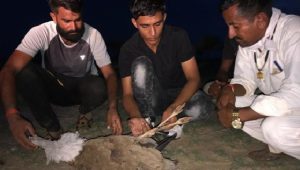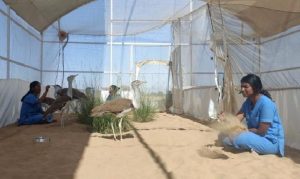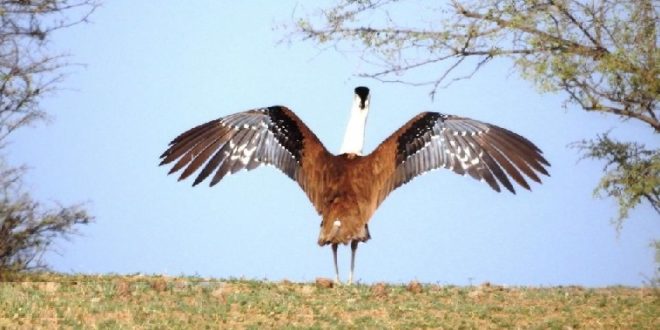09-11-2024
Bureau Report + Agencies
NEW DELHI: Last month brought good news for the great Indian bustard, a critically endangered bird found mainly in India.
Wildlife officials in the western state of Rajasthan have performed the first successful hatching of a chick through artificial insemination.
 A lone adult male in one of two breeding centres in Jaisalmer city was trained to produce sperm without mating, which was then used to impregnate an adult female at the second centre some 200km (124 miles) away.
A lone adult male in one of two breeding centres in Jaisalmer city was trained to produce sperm without mating, which was then used to impregnate an adult female at the second centre some 200km (124 miles) away.
Officials said the development was important as it has opened up the possibility of creating a sperm bank.
Over the years, habitat loss, poaching and collisions with overhead power lines have effected great Indian bustards. Their numbers have fallen from more than 1,000 in the 1960s to around 150 at present.
Most of them are found in Jaisalmer and hence, conservation activists say that the bird’s habitat in the city should be protected but this land is also prime real estate for renewable energy firms, presenting authorities with a unique conservation challenge.
The great Indian bustard may not be as well-known as the peacock (India’s national bird) but it’s just as impressive, says Sumit Dookia, a conservation ecologist who has been studying the bird for close to a decade. The massive bird, which weighs between 15kg and 18kg, is one of the biggest flying birds in India.
It once had a prolific presence in the country and was found in at least 11 states, but today, its population is confined to Rajasthan, while a handful might be spotted in the southern state of Karnataka and the western state of Gujarat.
The shy bird plays an important role in the food chain by preying on rodents, snakes and other pests and is also the state bird of Rajasthan, where it is called ‘Godawan’ by locals but some of the bird’s unique evolutionary traits are clashing with human interventions, making it vulnerable to extinction.
 For one, the great Indian bustard has good peripheral vision but poor frontal vision, making it difficult for them to spot power lines until they fly too close to them. Their large size makes it difficult for them to quickly change their flight path and they end up colliding with the cables and dying.
For one, the great Indian bustard has good peripheral vision but poor frontal vision, making it difficult for them to spot power lines until they fly too close to them. Their large size makes it difficult for them to quickly change their flight path and they end up colliding with the cables and dying.
“Their vision could have developed like this as the bird spends a large amount of time on land,” says Dookia. It also lays its eggs on the ground, without a nest or any other form of protection except for the watchful eye of the mother and this might have caused it to develop good side vision, he adds.
The great Indian bustard also has unique breeding habits. The bird lays just one egg at a time and spends the next two years caring for its offspring.
“Since it reaches maturity at around four years of age and lives for 12-15 years, it lays just about four-five eggs in its lifetime and many of these eggs are destroyed by predators,” Dookia says.
Conservationists say that over the past few years, the great Indian bustard’s habitat in Jaisalmer has been overrun by solar and wind energy farms, leading to an increase in flying accidents.
“The increased human presence has also created more filth, attracting stray dogs who kill the birds or destroy their eggs,” Dookia says.
To boost the bird’s population, the government of Rajasthan collaborated with the federal government and the Wildlife Institute of India to launch a conservation breeding centre at Sam city in 2018. Another breeding centre was set up at Ramdevra village in 2022, says Ashish Vyas, a top forest official in Jaisalmer.
 Pressmediaofindia
Pressmediaofindia




